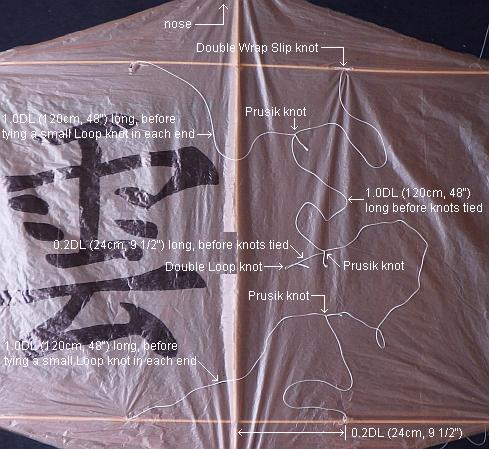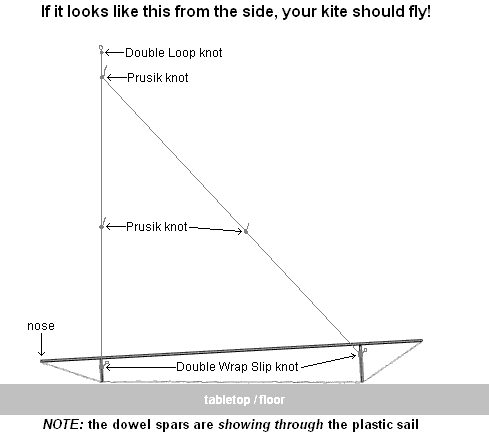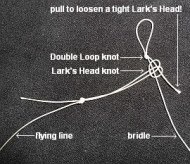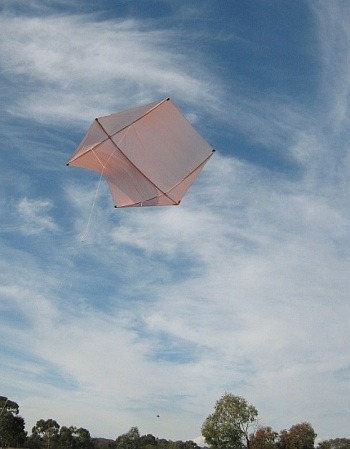- Home Page
- Better Kites
- ... Rokkaku Kite
How to Make a Rokkaku Kite
Step by Step—Page 3 of 3
The MBK Dowel Rokkaku
How to Make a Rokkaku Kite
Bridle
Dacron line in 50-pound strength is ideal for these Dowel Series kites.
All the construction details for the bridle are contained in the large photo below. Look and read carefully, and you can't go wrong on this rather important bit!
KNOTS
If you are new to this, you might need instructions on how to tie the following knots:
Loop knot
Double-Wrap Slip knot
Prusik knot
TIP: Secure the slip knots onto the dowels with enough wood glue to ensure the knots can never slip along the dowel. They won't loosen either.

ADJUSTMENT
Once your kite and bridle looks like the photo up there:
Hold the short bridle line up so all the bridle lines are straight, with the kite laying flat on the table or floor.
Make sure the Prusik knots closest to the kite are adjusted to the middle—right over the vertical spar.
Referring to the diagram below, shift the highest Prusik knot to the shown position. It's not necessarily the perfect position for your individual kite, but it should at least fly on the first attempt! Later, you can experiment with shifting the position towards or away from the nose, a little at a time, to improve how high your kite flies.

How to Make a Rokkaku Kite
Prepare to Fly

Make up a flying line and attach it to the bridle with a Lark's Head knot. See the photo, where the Lark's Head has been left loose.
Check the bridle slip knots on the horizontal spars. Retighten if necessary, or put a small drop of wood glue on each so they can never come loose. You won't have to wait the full drying time for this glue to dry, since the amounts are small.
How to Make a Rokkaku Kite
Flying!

First, if it's very windy outside, stay home!
This is a light-wind kite and won't like being launched in a gale or even a fairly fresh breeze. If the wind is too strong, it will deform badly and refuse to fly properly.
The Prusik knot on the bridle line can loosen off a little over time. If necessary, pull on all the lines to tighten the knot up before a flying session.
Assuming there is some breeze outside, just dangle the kite at arm's length until the wind catches it. As long as you feel the kite pulling, let out line slowly by taking loop after loop off the winder.
Be cautious about letting line slip through your fingers. If a big gust hits the kite, the line could burn you! For any kite this big or bigger, it's a good idea to wear a glove of some sort.
Another approach is to get a helper to hold the kite up and let it go, on the end of 10 or 20 meters of line. This way, the kite soon gets high enough to make it easy to let more line out.
Have fun flying, and I hope you've enjoyed learning how to make a rokkaku kite!
Out in the Field
Rokkaku-kite stories of my real-life flying experiences are worth checking out!
Illustrated with photos and videos, of course.
The e-book instructions for this kite include even more handy hints that will ensure you get the most success possible when flying this particular design. They show you how to make the kite more transportable too, so you can remove a spar and roll the kite up into a slim bundle.
Now, just in case you have actually made and flown this kite at least once already:
Flight Reports From Other Visitors
Click below to read about various kite-flying adventures, contributed by other visitors to this page...
Pushing the MBK Rokkaku Kite
Recently, I got the kite bug and again and I had to build something new. This time I wanted success so I set out to build an MBK Rokkaku kite that was …
Dowel Rokkaku — First Try
This is my first kite. I am living in Berlin, Germany and it has started to get windy! I thought it would be fun to build and fly a kite.
Here's my …
A Windy Winters Day
My kite flying spirit had been in hibernation for most of the winter. But today the wind was begging me for some kite action. Picking up some kites from …
As mentioned earlier, there's more kite making on this site than you can poke a stick at. :-)
Want to know the most convenient way of using it all?
The Big MBK E-book Bundle is a collection of downloads—printable PDF files which provide step-by-step instructions for many kites large and small.
That's every kite in every MBK series.
